As promised, I’m putting together some tambour embroidery instructional resources for those of you who are interested in learning this technique.
Today, we’ll look at three books that are good for instruction in tambour work. These are the three of four books that I’ve found most useful – I’m saving the fourth one for a full review, which I’ll have for you a little later.
In the meantime, though, these three are good. Only one of the three is completely dedicated to tambour work, while the other two have useful chapters on the subject.
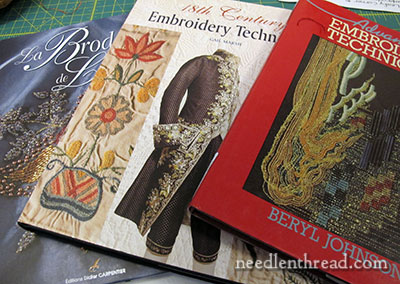
The three books shown here that instruct at least in part on tambour embroidery are:
La Broderie de Luneville by Roland Gravelier and Mick Fouriscot
18th Century Embroidery Techniques by Gail Marsh – I’ve reviewed this book already here on Needle ‘n Thread, and you can find the review here.
Advanced Embroidery Techniques by Beryl Johnson
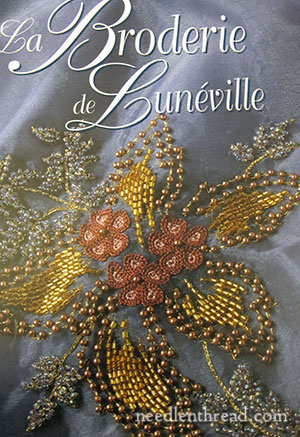
La Broderie de Lunéville is mostly devoted to tambour beading.
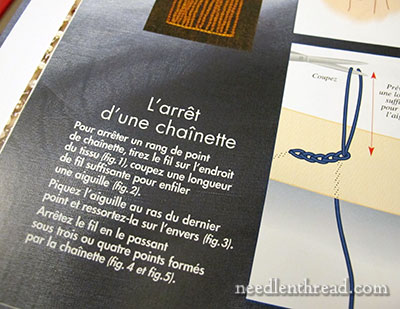
The text is in French, but for those who don’t read French…
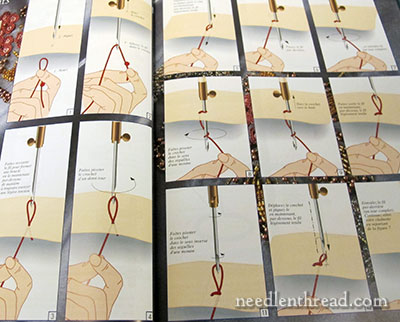
…the instructional diagrams are very self-explanatory and clear. If you don’t read French, and you really want to know what the text says on the diagrams, you can always type the captions into Google translate – the translations are fairly good.
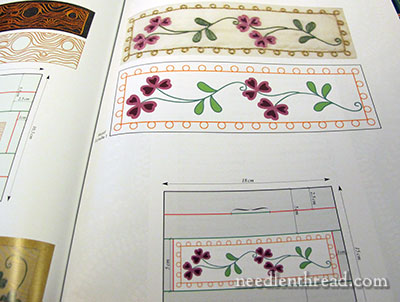
The book also offers several projects – a couple of which are tambour embroidery, the rest of which are beadwork.
What I like about this book:
It has clear illustrations for working the surface chain stitch with the tambour hook, with easy to understand starts and finishes. These instructions are separate from beadwork instructions, which is nice, because there are subtle differences between the two.
As far as clarity of visual instructions are concerned, this book is my favorite of these three.
You can find La Broderie de Lunéville through Lacis – it’s $28. Occasionally, you can also find it through used book sources or used on Amazon
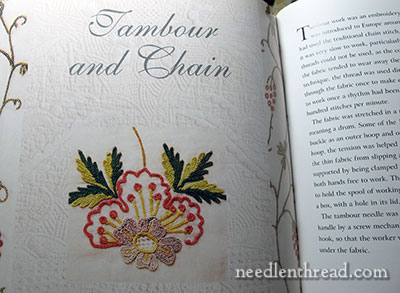
In 18 Century Embroidery Techniques, Gail Marsh devotes a section of the book to tamboured chain stitch, which was a popular method of doing whitework and colored embroidery on household goods and clothing in the 18th century.
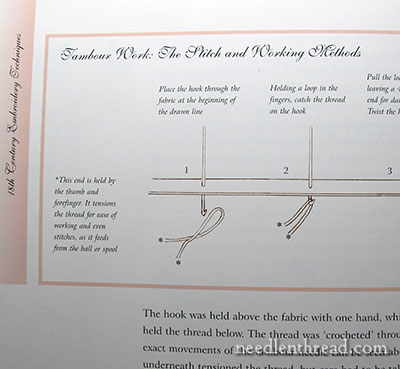
In this book, the illustrations and explanations of tambour chain stitch are straightforward and clear, though not as detailed as those in Broderie de Lunéville.
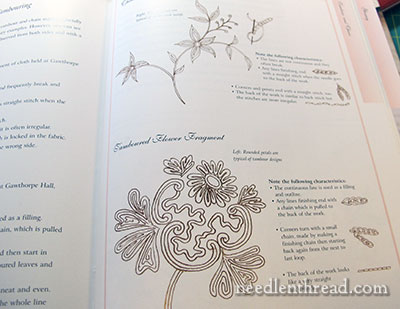
Marsh also goes into the differences between chain stitch embroidery worked with the tambour hook and chain stitch worked with a regular needle. She points out that there are specific design differences to consider as well.
What I like about this book:
The diagrams and explanations are definitely clear enough to get started, and she does instruct on beginnings and ends, as well as little things like turning a sharp corner. The instructions are not super detailed, but they are easy to follow and easy to learn from.
The book is widely available, and it is relatively inexpensive. You can find 18th Century Embroidery Techniques new on Amazon for less than $14.
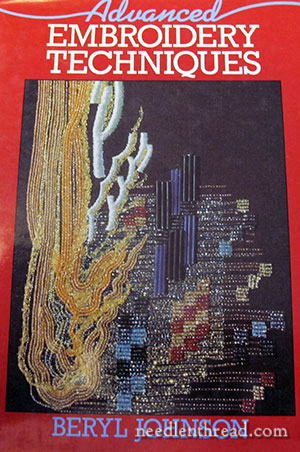
Advanced Embroidery Techniques by Beryl Johnson is a little bit deceptive, when it comes to the title – or at least it is, when read here on Needle ‘n Thread. You might be tempted to think it’s all about advanced hand embroidery techniques, like goldwork, dimensional embroidery, and so forth. The cover might lead you to this conclusion, too.
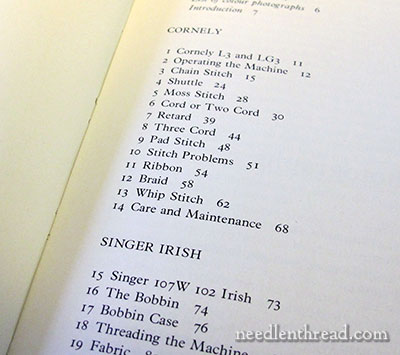
Published in the early ’70’s, the book is, in fact, about machine embroidery achieved with primarily two machines: the Cornely and the Singer Irish.
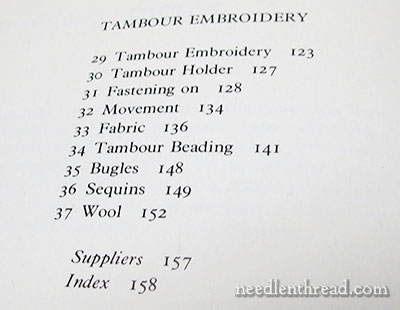
But there is a whole chapter at the end of the book devoted to tambour embroidery and beading.
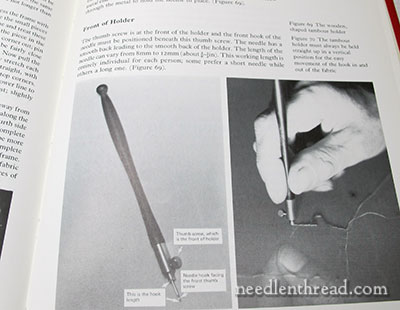
The photos – there are not a lot of them, as the chapter relies more on instructional text than illustrations and photos – are all black and white, but clear.
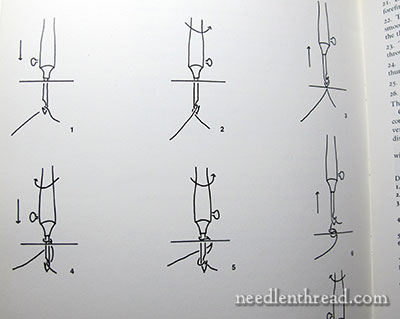
The diagrams are all these little pen drawn diagrams that are also very clear.
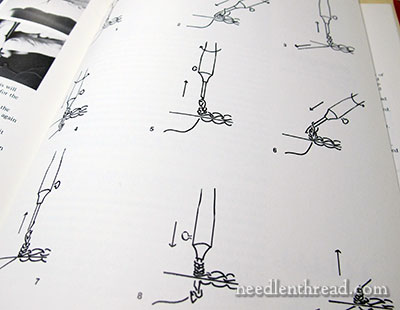
I’m not super-crazy about her explanations of starts and stops – they work better, I think, for beadwork than for embroidery.
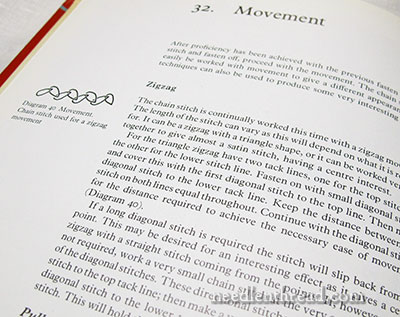
What she does do, which few other books go into, is discuss other “stitches” that can be accomplished with the tambour needle. In essence, they’re all chain stitch, but by the movement of the tambour needle, you can modify the look of the chain stitch to mimic other stitches, like buttonhole stitch, satin stitch, and even eyelets (or Algerian eye stitch, with a pulled open hole in the middle).
These are all techniques that were primarily used in tambour embroidery on net, to create tambour lace.
Unfortunately, these “movement” techniques are not illustrated, except with a finished picture of a sampler, and the techniques shown on the sampler are not identified. They are just discussed.
The explanation for working the movements, then, are all written explanations, and it takes reading them step-by-step and sitting with the tambour hook to figure out exactly what she’s telling you to do. It works! But it is not as “easy” as we have become accustomed to, with all our clearly illustrated instructional books of today.
What I like about this book:
The author goes into detail about other effects that can be achieved with the tambour hook. The illustrations for basic tambour stitching are clear enough, too.
Advanced Embroidery Techniques is only available through used sources, and these days, you’re lucky if you find it for under $50. I was fortunate to get mine at a library used book sale a while ago for 50 cents – so if you have library sales, scour them! Or just check your library to see if they have it or can get it for you.
I know that Lacis also sells the book, but they’re asking $160 for it. If you’re just out to learn tambour work, it’s not worth the high prices, as you can learn basic tambour embroidery through the other books above just as well.

And there you have three books that I think are useful for learning tambour work. If you have 18th Century Embroidery Techniques on your bookshelf already, it’s a good place to start!







Dear Mary
I like the detailed photos and the projects offered of La Broderie de Luneville and I like the idea of different stitch techniques in Tambour work by Beryl Johnson, All three books look interesting and they all have useful tips on Tambour work thanks for reviewing the books and sharing them with us. I can’t wait for the full review on book 4.
Regards Anita Simmance
Hi, Anita! It’s coming soon – must photograph first…and finish reading….! -MC
Dear Mary
I will be getting 18th Century Embroidery Techniques book for Christmas I’m so excited thanks Mary for reviewing and posting it. Christmas is going to be fun with all my Embroidery book presents!
Regards Anita Simmance
Hello, I have just recently discovered your site, I am very interested in this type of embroidery, but I am unable to find the Tambour hook anywhere. Do you have any suggestions? Thank you, your site is so easy to understand and I really enjoy it.
Hi, Correna – you can find a tambour handle and needle set at Hedgehog Handworks or at Lacis online. Both shops carry them. Glad you enjoy Needle ‘n Thread! – MC
Looks so difficult, but I sure would love to try it.
For those who can read French, there are two books about “Point de Beauvais” (tambour work).
“Le point de Beauvais” by Duchenoy and Fouriscot.
“Le point de Beauvais de A à Z” by Marie-Claire Chambon. But none of them is clear enough for a total beginner !
I bought them, but had to take lessons to understand how that tricky hook works…
The first book you mentionned is the best I know to explain the movement of the hook and the thread.
Thanks a lot for all you share.
Hi Mary,
I was given an old vestment with the chain stitch work which literally flaked off as I tried to renew the chain stitching with new thread. Should I sketch the design and colors and remove all the old stitching before trying to repair it?
Thanks,
Ji
Mary,
Thanks for continuing to discuss tambour work and calling our attention to these books. Fortunately I’ve got the one on 18th Century Embroidery Techniques so will have to get it out and give this another try.
Personally i’d rather use a needle. So much easier…..
The cover photograph of La Broderie de Lunéville looks delicious.
Great books! I am learning to do tambour embroidery and have been looking for some good books with illustrations. These look great! I’ll have to try and order them online. It is such a beautiful art, wish there were more videos and instruction out there. Appreciate the info and demonstrations that you have shared.
Thanks,
Sue Leatherman
this looks fabulous!
i’ve got the Gail Marsh book on hold at the library now
i’ve been happily struggling with my bead embroidery, doing a passable job with single needle couching
but this! this looks fabulous!
thank you!
Mary, thank you for sharing the information for these three books. Friday afternoon I went to the nearest embroidery store to pick up some thread and a goldwork book, only to find that this morning they had put out some new books. Right there was a single copy of the 18th Century book. I am very glad that you had written the article on Thursday!
Hi Mary,
I bought a book published by Lacis, named “Tambour Work”. I haven’ tried this technique yet but am interested in how fast you can do it with practice. I have seen on YouTube some Indians laying beads and working at an amazing speed. They do it for a living and the muslin they work on is taut as a drumskin.
In Central Asia some suzanis are embroidered with the Cornely machine (videos of this abound on YT) and the Kashmir has a long tradition of embroidering with wool on coarse cotton fabric. They make carpets and smaller items, all with lovely foliage and the entire surface is covered with this stitch. Can’t remember how they call it right now.
The designs for tambour have to present a continuous line to avoid interruptions, this is one special requirement and the book has lots of these. The Antique Pattern Library also has albums of such designs.
Hi Mary, thanks for this review of tambour content books, seems that there are more I need to add to my library.
One that you probably have but might not have thought to look in for tambour information is Embroidery with a beads by Angela Thompson, it was recommended to me as it has a chapter on tqmbour work, including draw back stitch (used to replicate satin long and short stitch), and a variation on a draw back stitch that can be used to attach sequins and looks like a buttonhole stitch.
The diagrams are basic, and the instructions mostly text – but they work, this was the book that enabled me to understand how to fasten on and fasten off. Angela provides 12 variations of tambour stitches in a sampler diagram on page 96.
Cheers
Stella
Hi, Stella – thanks for the recommendation! And – wonder of wonders, I have that book! It’s just a matter of digging it out. In Advanced Embroidery Techniques mentioned above, Beryl Johnson also discusses various approaches to draw back stitch, including the buttonhole one, which can be used as an edging in cutwork and in net embroidery. But there are no diagrams. The instruction is all text and can be confusing. I’ll dig out Angela Thompson’s book and compare the two. Though I have the book, I don’t think I’ve ever actually looked inside it – it was one of those library sale / used book shop acquisitions. But now I know, so thank you!
I began looking on utube to find someone who might be doing embroidery with a crochet hook. I was interested in putting my granddaughter’s name on a pillow case. And lo and behold, I came upon your site! Thank you for all the information and a new beginning with tambour work for me.
Would like to order the books.
Hi, Marlene – you’re best bet is to check used book sources for these particular books on tambour embroidery.
Hallo Madam , I am seham , I am from Egypt, and I will be grateful if you give me a copy of these three books .
The book above that you suggest, La Broderie de Lunéville, is now around £400 and I can’t find it on the site you suggest.